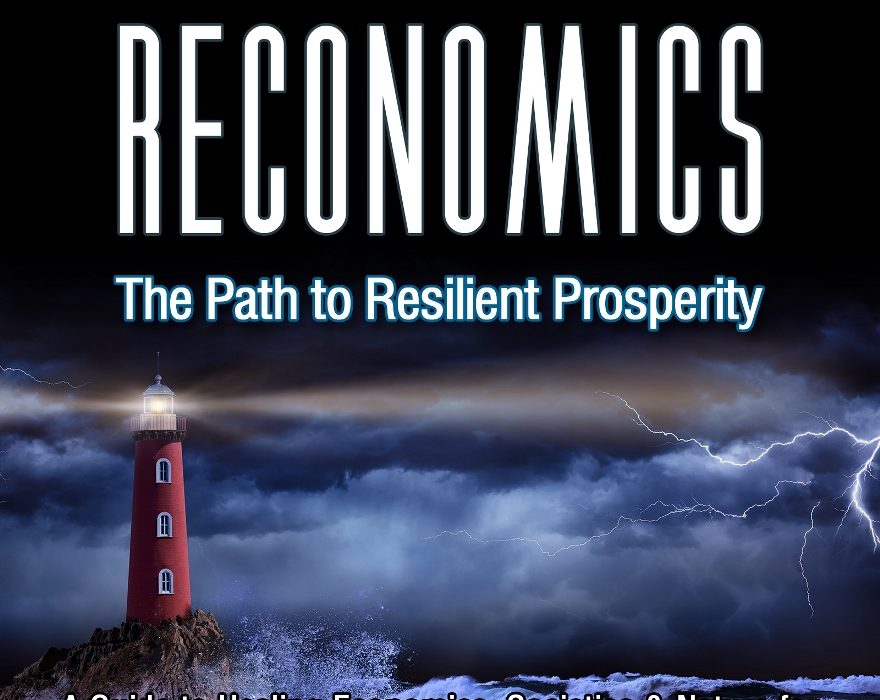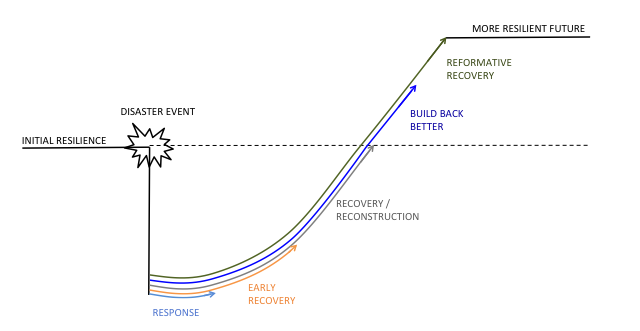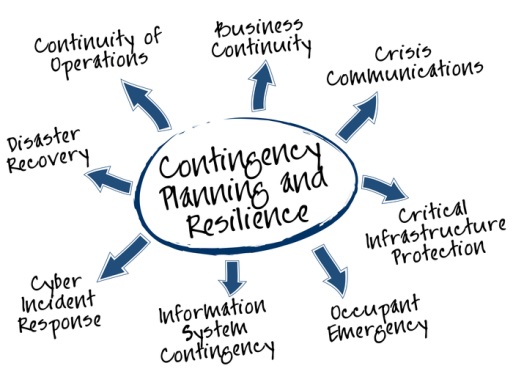Resilience and Climate Restoration: All communities and nations want it, but how to achieve it?
Several REVITALIZATION readers have asked me whether the multitudinous present-day efforts to achieve community resilience are actually to achieve their goal. Everyone believe in their goal, but not everyone believes they know how to achieve it. Here are some thoughts on the subject, extracted from the current draft of my third book, RECONOMICS (coming January 2020).
There really is this claustrophobic pressure to innovate instead of to adapt.
– Chelsea Clinton, Vice Chair of the Clinton Foundation
Resilience is revitalization plus adaptability. Revitalization makes poor (or damaged) places wealthier, and wealthy places healthier. It makes healthy, wealthy places healthier, wealthier, and happier. Adaptability helps make the good times last. Resilient Prosperity, in other words.
We should keep in mind that health, wealth (in its holistic sense), and happiness are all emergent qualities of doing the right things in the right way for the right amount of time. So, they should not be goals in themselves. Their nature is too ephemeral, and their emergence is too unpredictable to serve as deliverables. As Eleanor Roosevelt wisely said: “Happiness is not a goal…it’s a by-product.”
Most folks can define resilience along the lines of “the ability to bounce back from adversity or trauma, or adjust to change”. Traditionally applied primarily to materials and individuals, it has now become a goal of institutions and communities (as well as restored ecosystems). [Note: I use “resilience” in this guide, rather than “resiliency”. Their meanings are identical, and both are real words. But “resiliency” is mostly used (about 50% of the time) in informal American conversation. This guide uses the shorter, more elegant form preferred by scientists and educators, and by the English-speaking public worldwide.]
A systems-oriented definition is: “the capacity of a system to absorb disturbance and re-organize while undergoing change so as to still retain essentially the same function, structure, identity, and feedbacks”.
In their popular 2012 book “Resilience: Why Things Bounce Back”, authors Zolli and Healy offer an institutionally-oriented definition: “the capacity of a system, enterprise, or a person to maintain its core purpose and integrity in the face of dramatically changed circumstances.”
Combining a goal of resilience with an adaptive process of revitalization is a strategy for Resilient Prosperity. Simply doing regeneration and redevelopment isn’t enough. We can improve the current conditions of a place on a present on a property-by-property basis, but still not alter its downward trajectory. Revitalization without resilience and good management seldom lasts, which is why it’s just one of three processes contributing to an Adaptive Renewal strategy for achieving Resilient Prosperity.
Resilient solutions are normally 1) redundant (to endure loss or damage); 2) flexible/scalable (to endure growth, contraction, and change); and 3) integrative/strategic (to endure time and heal fragmentation).
Most renewal projects have managers with relevant training and licenses: historic restoration, watershed management, civil engineering, etc. Revitalization and resilience programs designed to achieve Resilient Prosperity (in the few cases where they exist) also have professionals at the helm, but they lack revitalization or resilience credentials. At best, they specialize in one small aspect of renewal.
It’s like being put in charge of renovating a region’s electrical grid, simply because you know how to change a light bulb. Many public and private leaders work heroically to renew their cities, regions, and nations. But their efforts are undermined both by revitalization ignorance, and by a short-term, crisis-response mentality that produces one-time—rather than ongoing—revitalization efforts.
Resilience leaders are often hampered by the opposite problem: a purely long-term focus with little or no pressure to produce tangible results in the short term. Only by combining revitalization and resilience goals can we improve the present and future simultaneously.
The desire for revitalization can be triggered by a long, slow decline, a sudden disaster, or simply dissatisfaction with the current quality of life. The desire for resilience is often triggered by recent or impending disaster: a fishery on the edge of collapse, a fragile economy, climate-related agricultural challenges, etc. So, revitalization is usually motivated by present-day pain, whereas resilience is usually motivated by a desire to avoid future pain. The two goals have obvious overlaps.
“In the field of sustainable cities, Herbert Girardet’s name is legendary. He has made the discipline his life’s work. But now he’s left the concept of sustainability behind, moving on to define a new, more dramatic concept: the idea of regenerative cities.” – journalist David Thorpe, Nov. 12, 2014
This book is not about resilience in the usual sense. There are many excellent books on that subject. The most recent is The Resilience Dividend, by Rockefeller Foundation CEO, Dr. Judith Rodin, published in November of 2014. Her 384-page work on resilience includes a chapter on revitalization.
This book has the opposite emphasis: it focuses more heavily on revitalization, and its role in resilience. That’s because resilience–as a goal–is the newcomer, whereas revitalization, regeneration, and redevelopment agencies and budgets have been around for decades, if not centuries. Refocusing these established community and regional assets on Resilient Prosperity is thus the low-hanging fruit. An obvious relationship between resilience and regeneration is in post-disaster situations, as illustrated by this diagram. It uses the phrase “reformative recovery” in the manner I use “improving the future”.
Resilient Prosperity thus comes at resilience from an oblique angle. Rather than focusing on traditional resilience strategies: it’s an attempt to show how the parallel trends/activities of community revitalization and natural resource restoration are ideal paths to a resilience effort. This is as opposed to launching yet another silo called “resilience”.
The word “resilient” suffers (to a degree) from the same problem that afflicts “sustainable”: it implies protecting current conditions. Anyone who thinks simply reducing the amount of new damage we do will be sufficient just isn’t paying attention to the vast amounts of damage already done. Who wants to sustain this mess? We need a global transformation. At its core would be a wealth of “re” words regarding our natural, built, and socioeconomic assets: restoring, reconnecting, repurposing, renewing, redeveloping, renovating, revitalizing, regenerating, etc.
Image credit: David Lallemant
As Zolli and Healy state in their book, “preserving adaptive capacity—the ability to adapt to changed circumstances while fulfilling one’s core purpose—[is] an essential skill in an age of unforeseeable disruption and volatility.” This is where most resilience efforts falter. They know that the most important principle of resilience is flexibility, yet they try to use their old, inflexible planning and management systems to implement it. It’s like removing tumors with a shotgun: simply not the right tool.
A related area in which resilience efforts get into trouble is in making safety their primary (or even sole) goal. Safety sounds like a reasonable objective, especially for public officials. But it can become a rigid, fear-based religion, preventing us from taking the risks needed to innovate and become more flexible and, ironically, safer. There is no complete safety: there is only safer. In excessive fear lies vulnerability. As Will Rogers said, “You’ve got to go out on a limb sometimes, because that’s where the fruit is.”
Redundant, flexible/scalable, and integrative/ strategic are thus the key (not only) factors in creating the resilience element of an Adaptive Renewal. But again: resilience by itself won’t produce prosperity: revitalization does that. Resilience makes revitalization durable, and adaptive management keeps it relevant via flexible implementation.
Together, these three elements form an Adaptive Renewal process for achieving Resilient Prosperity. Adaptive management is a process of constantly reorienting towards what actually works. It’s the key to making resilience initiatives resilient, so we’ll explore that in the next chapter.
Image credit: Shutterstock
In today’s climate of uncertainty,
resilience efforts increasingly focus on pre- (not just post-) disaster situations.
Resilience and adaptation most often converge when places prepare for climate change-related sea level rise and storms. Not surprisingly, Florida has a great deal of activity in this regard. Their Department of Economic Opportunity (DEO) has web resources on community resilience and adaptation planning. It describes three basic strategies for coastal communities in response to sea level rise: protection (armoring the shore with hard and/or green infrastructure), accommodation (elevating structures to minimize flood damage), and retreat (turning at-risk areas into parks, and moving structures to safer locations).
In 2012, the Florida DEO launched a 5-year project called “Community Resiliency Initiative: Planning for Adaptation”. It integrates adaptation to potential sea level rise into all three local planning mechanisms: the comprehensive plan, the hazard mitigation plan, and the post-disaster redevelopment plan.
It is good to have an end to journey towards, but it is the journey that matters, in the end.
– Ursula Le Guin, American writer
But adaptation efforts are not the same as adaptive management. While shared visions and goals can enhance success, adaptive management helps ensure progress even in their absence, and even when the goals turn out to be faulty. Adaptive management is thus more focused on the journey of renewal, rather than the destination.
About the Author
Storm Cunningham is the publisher of REVITALIZATION, a new twice-monthly global magazine (http://revitalization.org ).
Since 2002, he has been a full-time revitalization coach for organizations, communities and regions. He is also a professional speaker and workshop leader on community revitalization, economic resilience, and natural resource restoration. His clients include national and local governments, universities, and non-profits in over a dozen countries.
He lives in Arlington, Virginia, and is the author of two highly-acclaimed books:
The Restoration Economy (Berrett-Koehler, 2002), and Rewealth (McGraw-Hill Professional, 2008).
See http://RestorationEconomy.com and http://Rewealth.com for more information about these books.
His third book, RECONOMICS, will be published in November of 2019.
See http://StormCunningham.com for more on his work.
Storm can be reached at 1-202-684-6815, or at storm@revitalization.org



